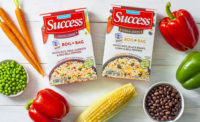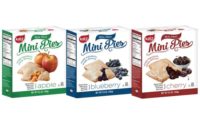Prepared Cakes and Pies: Resisting the Recession


Photo courtesy of Mintel GNPD


September 2011/Prepared Foods -- Whether it is a continued love of comfort foods, finding comfort in indulgence or rooted in a renewed focus on eating at home, Americans continue to buy prepared cakes and pies through FDMx (food, drug and mass marketing) channels. While the market did experience a slowdown in 2007 and 2008, overall, there was an increase of 19% from 2005-2010, and sales reached $2.4 billion last year. Furthermore, Mintel’s projections suggest the market will continue to grow through 2015, by more than 5% annually-- driven in part by renewed consumer confidence, as the economy improves, and as consumers begin to worry a little less about every cent.
Consumer trends driving the market are a continued need for convenience and, to some degree, less focus on fad eating, such as the low-carb diet. There are, however, clouds on the horizon. Continued innovation from in-store bakeries will impact packaged sales, as the perimeter of the store grapples for attention with added freshness and mid- to premium-range products that appeal to a “treat mentality” for the shopper looking to take home something special. While Mintel has seen sales through in-store bakeries fall from 2008-2010, their ability to develop new products quickly, lower cost of innovation and easy ability to see what works in their locale certainly gives them a potential edge. In addition, while Mintel does not expect the cupcake trend to provide significant competition, the explosion of cupcake stores is symptomatic of the potential for new competition to quickly appear.
In-store Bakery Woes
In-store bakeries (ISBs) in both mass merchandisers and supermarkets have been the focus of significant investment, and many have made the effort to make them more upscale. In addition, ISBs often sell packaged products--stacked or shelved in the front of the bakery itself--which tends to blur the line as to what is ISB-produced (in-store) and what is pre-packaged. And, if it is pre-packaged at the ISB, what is the difference between this and the packaged bakery produce on the shelves?
ISB sales between 2008-2010 fell 1.9%, despite the fact that some ISB segments grew (notably upscale dessert cakes). This decrease is largely the result of higher prices that might be all right for certain consumers looking for a treat, but did not gel with the overall needs of most in a recession mindset. The increased demand for upscale dessert cakes dovetails with the growth of the cupcake market, as consumers look for everyday indulgences, as opposed to cakes for birthdays or other special occasions. The fall in sales of custom-decorated cakes is also consistent with this theme, and ISBs will have to revisit how these products and services are offered, if they want to revitalize sales. If the renewed interest in red velvet cake is any indication, perhaps a focus on heritage-type cakes would be a good idea. An alternative approach may be actively promoting locally produced goods, as the locavore movement exemplifies. Interestingly, burger chain 5 Guys has actively used this approach in its French fries offerings, promoting the grower and type of potato used to generate a more local feel.
Specialty Retail to Private Label
The growth of specialty retailers, such as specialist bakeries and cupcake stores, has without doubt placed pressure on both in-store bakeries and prepared baked goods at FDMx. While Mintel does not expect the cupcake store to be a significant player in this market, their growth has nonetheless been dramatic, despite the fact that prices seem to be in direct contradiction to what might be expected in this sluggish economy. However, it is clear that stopping for coffee and a cupcake is seen more as a convenient break or a treat, rather than buying them at retail.
While the pace of growth in stand-alone cupcake stores is slowing, they remain a source of competition within the prepared cakes and pies marketplace. Reality television shows, such as Ace of Cakes and Cake Boss, are having a similar effect on specialty cake stores that cater to those looking for personal, unique creations. Even Au Bon Pain and Starbucks added cupcakes to their menus in late 2010, reflecting the popularity of the single-serve treats.
Store brand is the largest brand in many of the prepared cakes and pies segments. As discussed further below, store brands have driven growth of refrigerated and account for almost 80% of FDMx sales. While not quite so strong, private label is also the strongest brand in both shelf-stable cakes (64% of FDMx last year) and pies (56%). With the exception of shelf-stable pies, private label has continued to take share from the brands, when comparing 2008-2010. However, in pies, more recent data shows private label share increasing. The private label effect has had a two-fold impact on the market--it has both driven down prices for products (thus, overall dollar sales), and it has kept consumers in the market, by offering economically priced sweets, even as household budgets have shrunk.
So, while many consumers continued to indulge in more specialty products from independent bakeries, others have found the quality of private label good enough to satisfy their taste buds. As consumers redefine value, private label products have improved their taste, packaging and image to better meet consumer needs.
Even convenience stores have added private label baked goods lines. In late 2009, convenience store chain 7-Eleven announced it was adding a 15-item line of private label mini-doughnuts, chocolate cupcakes, Danishes, snack pies, honey buns and gold crème cakes at its stores with a 99-cent price tag until the end of 2009, after which the price rose to $1.19 per item.
Growth in Packaged Refrigerated
Refrigerated prepared foods are more popular in the U.S. than Europe. While supply chain issues are a factor, higher costs have often been cited as reasons for lower sales. However, packaged refrigerated cakes and pies is one area in which strong growth has been seen, and sales grew by $31.7 million (+31%) from 2008-2010 through FDMx. This is a period when the combined effects of the recession and strong focus on store brands by many major retailers led to the growth of private label, and it is the private label refrigerated cakes and pies that accounted for much of the segment and its growth. Private label refrigerated cakes and pies accounted for 78% of segment sales in 2010, up from 69% in 2005.
Additionally, greater perceived freshness of refrigerated products relative to shelf-stable products, as well as growth in indulgent single-serve desserts in refrigerated sections, has helped to grow the segment--as consumers look for affordable indulgences. Also, during the recession, while ISB sales of custom cakes were down, consumers did spend on occasion cakes and treats for children’s and family parties--in order to maintain a sense of normalcy and to indulge in affordable treats.
Although not expected to maintain the 23% growth in 2010, sales of FDMx refrigerated cakes and pies are forecast to remain strong through 2015. While both cheesecakes and refrigerated cakes and pies require refrigeration, the high dairy content of cheesecakes may make consumers more wary of transport than other refrigerated cakes and pies, which have a lower dairy content that can potentially survive without refrigeration for a longer period of time. Refrigerated cakes and pies also have been faster to innovate and are not limited by a stricter definition, as cheesecakes may be.
Consumer Trends: Age, Income and Ethnicity
Mintel-commissioned consumer research shows more than two thirds of all respondents purchase RTE baked goods from the packaged foods section of a grocery store or from an in-store bakery. It is quite clear that neither the bakery aisle nor the ISB monopolizes purchases, and baked goods are purchased from both locations, for different needs and occasions.
Respondents who are 35 or younger are slightly more likely than their older peers to purchase RTE baked goods from the packaged foods section of grocery stores, while those aged 65+ are much less likely to purchase from the packaged foods section. The higher-than-average share of respondents aged 35 and younger who shop in the packaged foods aisle could be a reflection of their high consumption of snack cakes, which are mostly found in this aisle. Snack cakes could also be a reason why purchases in the packaged foods aisle decline for consumers aged 65+, as older adults are less likely to eat snack cakes.
The likelihood of purchasing RTE cakes and pies in a gourmet food shop peaks for consumers aged 25-34 and declines for respondents aged 44+. This is most likely related to the wider variety and amount of baked goods eaten by younger adults, as respondents aged 25-34 reflect a slightly higher share that shop at all retail channels, compared to the other age groups.
Significantly more black respondents eat any type of RTE baked goods compared to the total sample, while Hispanics are more likely than the total sample to eat cakes or brownies. Asian respondents are also more likely to eat brownies, but incidence of consumption of other baked goods is not significantly higher than the total sample. These results indicate blacks are an important part of the market for RTE baked goods, due to their above-average consumption of prepared sweets. The U.S. black population increased by 5.5% from 2006-2011 and is expected to grow by 5.6% from 2011-2016, but the growth in actual number of people is dwarfed by the growth in the number of whites or Hispanics.
Blacks also have a higher incidence and risk for diabetes in the U.S. According to “National Diabetes Statistics 2011” (Centers for Disease Control and Prevention National Diabetes Fact Sheet: national estimates and general information on diabetes and pre-diabetes in the U.S., 2011), the risk of diagnosed diabetes among non-Hispanic blacks was 77% higher, as compared to non-Hispanic white adults. Hispanics/Latinos also have a higher risk for diabetes, with a 66% higher risk than for non-Hispanic white adults--the risk for Mexican-Americans and Puerto Ricans is much higher than for those of Central or South American heritage or Cuban-Americans.
The higher risk for diabetes among blacks and Hispanics means these growing demographics are increasingly important target markets, based on their preferences for prepared baked goods. However, many among these growing populations may also increasingly be unable to eat such foods.
The share of black respondents actively looking for low-sugar or sugar-free options in prepared baked goods is not significantly different than that of whites--even though whites have a much lower incidence of diabetes, indicating that, while blacks may need sugar-free options, they are not actively seeking them. This means although blacks and Hispanics are at higher risk for diabetes--and, therefore, good candidates for sugar-free offerings--thus far, they have not been attracted to sugar-free products. Manufacturers may find it difficult to convince this group of the tastiness of such options, despite their healthfulness. pf
| Differentiating with Fruit, Nuts and Grains |
|
Ingredients such as ancient grains, seeds, fruits and nuts are one way to differentiate products. Often, such ingredients are found in specific categories. For example, using Mintel’s GNPD and searching for new products in the “Cakes, Pastries & Sweet Goods” category in the North American marketplace in 2010 that contain at least one of these ancient grains (sorghum, millet, quinoa, amaranth flour or teff), only three products are found. The same search in the “Bread and Bread Products” category brings up 39 new products. The reverse trend is seen with nuts. That is, when looking for new bread products in 2010 that have at least one of these components--walnuts, pecans, almonds or cashews--only six products appear. In contrast, some 98 new products appear in the “Cakes, Pastries & Sweet Goods” category. Fruit use is similar to nuts, in that some 279 new 2010 items in the sweet goods category contain at least one of these: blueberries, apples, cherries, raisins or figs. Conversely, only 91 new bread products contain those ingredients. Perhaps one “easy” form of innovation is to use an inclusion in a product category where it is not normally found. Cherries or figs in bread? Only one new bread product turned up in 2010 in North America, a fig-containing Date & 9 Cereals Berber Bread from Les Aliments Magrébia in Canada. --Claudia D. O’Donnell, Chief Editor |
Looking for a reprint of this article?
From high-res PDFs to custom plaques, order your copy today!







